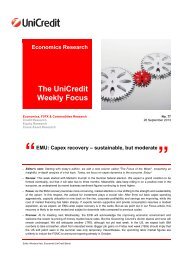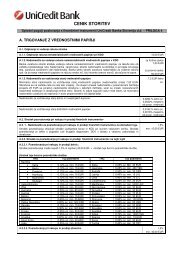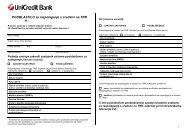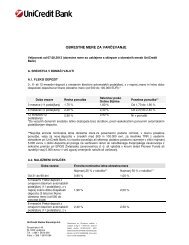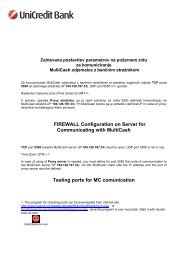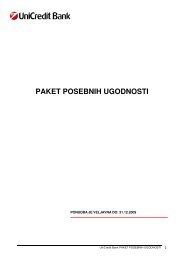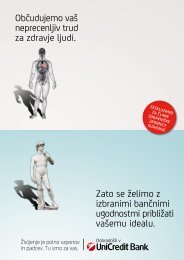Letno poroÄilo 2009.pdf - UniCredit Banka Slovenija dd
Letno poroÄilo 2009.pdf - UniCredit Banka Slovenija dd
Letno poroÄilo 2009.pdf - UniCredit Banka Slovenija dd
- No tags were found...
You also want an ePaper? Increase the reach of your titles
YUMPU automatically turns print PDFs into web optimized ePapers that Google loves.
Risk ReportRisk ReportThe following table breaks down Bank’s exposure by region.Credit risk profile by region Exposure (in Million EUR) Growth31. 12. 2009 31. 12. 2008 in %Slovenia 2,072.39 2,012.63 2.97%Eastern Europe 13.05 22.54 (42.09%)Southern Europe 61.53 81.49 (24.50%)Western Europe 547.59 261.35 109.52%Other 1.03 1.37 (24.34%)TOTAL 2,695.59 2,379.38 13.29%Please note that in both tables credit exposure is expressed in terms of gross values including impaired amounts. Impairments amountincluded for 31. 12. 2009 figure is 37.55 million euros and for 31. 12. 2008 the amount is 25.47 million euors.CollateralIn order to mitigate credit risk, the Bank is taking collateral in order to secure risk exposure. The Bank has implemented a collateral guidelinethat defines appropriate types of collateral. In general, collateral types for loans and other credit risk exposures can be segmented in:• Mortgages over residential and business properties;• Pledge over movables and cash deposits;• Charges over financial instruments such as bonds and shares.In general, riskier and longer-term exposure requires more collateral. According to collateral guidelines, collaterals are exposed to a regularreviewing process, either on individual or portfolio basis. Such approach gives the Bank a better view of the current status and actual value ofcollateral.The major types of collaterals are mortgages on residential and commercial real estate, as well as guarantees. Among the other types ofcollateral, financial collateral is the most common. The Table bellow shows distribution of on-balance exposures and assigned collaterals fornon-bank customers by the risk classes, which are in line with Bank of Slovenia risk classes.Risk classes by asset quality typesExposure(in Million EUR)Collateral value(in Million EUR)Exposure(in Million EUR)31. 12. 2009 31. 12. 2008Collateral value(in Million EUR)Standard (A) 2,063.40 1,006.48 2,043.40 859.30Watch (B) 11.36 6.44 6.25 4.43Substandard (C) 28.51 8.36 12.42 7.11Doubtful (D) 16.69 5.25 18.05 7.31Loss (E) 14.51 0.83 10.46 1.98TOTAL non-bank clients 2,134.47 1,027.35 2,090.58 880.13Please note that in the table above credit exposure is expressed in terms of gross values including impaired amounts. Impairments amountincluded for 31. 12. 2009 figure is 37.55 million euros and for 31. 12. 2008 the amount is 25.47 million euros.IMPAIRMENT AND PROVISIONING POLICIESThe Bank has a defined procedure and internal policy on the monitoring of portfolio as well as for creation of impairments. Internal policyalso is in line with strict regulation by the central bank. The Bank has a support system to create impairment on a client level or even for eachsingle deal. The Bank implements a so called “default event” on the client level if any client is in delay for more than 90 days with paymentto the Bank. Consequence of such action is downgrading of the client and creation of impairment on the client or transaction level, dependingon the situation. This procedure is prescribed by guidelines. The responsibility for the portfolio monitoring is with the Credit Risk Controldepartment, checking the whole portfolio at least on a monthly basis.According to guidelines, the Bank has five different impairment classes for the retail segment and 29 different impairment classes for the208 2009 Annual Report · <strong>UniCredit</strong> Bank



